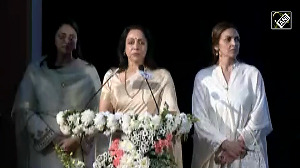Most malls today justify their rentals on the basis of "footfalls" (or the number of people who visit the mall) and "conversions" (the number of the "footfalls" that open their wallets).
DLF's City Centre in Gurgaon, for instance, justifies rentals of Rs 150-180 per square foot on the ground floor on the basis of 7,000 footfalls on weekdays and 12,000-15,000 on weekends.
While some, like S V Phene, corporate planning vice-president of Trent Ltd, the owners of the Westside chain, remain sceptical about footfalls -- his view is that they will fall, and that conversion rates in malls are significantly lower than in standalone stores -- others like Raghu Pillai, president and CEO of RPG Enterprises retail foray, are quite ecstatic.
"The FoodWorld in the Spencer Mall is the second most profitable we have, and the conversion rates for the MusicWorlds are lower in the malls, but then, at 60 per cent, it is quite high, especially considering the higher footfalls."
Yet, the fact is the country's first mall, Crossroads in Mumbai, has seen footfalls fall to a fourth from the heady days in 1999, when weekend footfalls used to be 80,000 and 40,000 on weekdays.
Mall CEO Krish Iyer says this has more than been made up by a sharp hike in conversion rates (one in 10 visitors spent money in 1999, and this is up to seven today, with the average size of purchase up four times, to Rs 2,000).
Everyone in the mall, however, does not share the view. While United Colors of Benetton said the conversion rate is up from 30 earlier to 50 now, Hallmark Cards says both the footfalls (from 1,000 to 400) and conversions are down (from 100 per cent to 40 per cent), a point repeated by Groove, the music store.
The main store Piramyd's conversion rates are between 30 per cent and 40 per cent.
In Gurgaon, while it is too early to talk of a saturation in footfalls, according to Pranay Sinha, who heads the retail practice at real estate consulting firm Jones Lang LaSalle India, "40-60 per cent of the traffic to Gurgaon's malls comes from Delhi -- once Delhi's malls come up, in the next couple of years, this is bound to come down."
The fact that it takes anywhere between 70 and 90 minutes to reach the malls from south Delhi doesn't help either.
A major issue, according to Sinha, is that malls are getting their tenant mix all wrong.
"A Sarojini Nagar market's message is that it is for the very value-for-money customer, a Khan market's is that it is for the well-heeled. Malls need to send the same message out," he says.
Yet, with 60 per cent of the shops sold to the occupants in DLF's City Centre, for instance, there is little mall developers can do to control this.
The result is a mish mash of shops whose clientele clash. Iyer, for instance, says that, in retrospect, getting in Pantaloon at the Crossroads mall was a mistake -- while the mall is positioned as a very upmarket place with brands like Zegna and Swarovski, Pantaloon has a middle-class tag to it.
With the tenant mix a serious problem, mall-developers have, instead, opted for the softer concept, that of the anchor tenant -- get the correct anchor tenant, and the mall will take care of itself.
The problem, however, is that there are just so many outlets that a Pantaloon/Big Bazaar, a McDonald's or a Westside can open.
According to a Fitch Ratings study, Shoppers Stop, Pantaloon and Trent (the biggest three retailers) plan to expand their operations by around 350,000 square feet in the next year -- minuscule, in comparison with the 10-12 million of mall space expected to come up in just the next 12 months.
Getting the product mix right is another major issue.
According to KSA Technopak chief Arvind Singhal, "While just around 6-7 per cent of a consumer's discretionary spending is on clothes, for instance, most existing malls have around 60-65 per cent of their existing space dedicated to clothes," he says.
"Grocery accounts for 42 per cent of spend, but apart from the Sahara Mall, few Gurgaon malls have grocery outlets."





